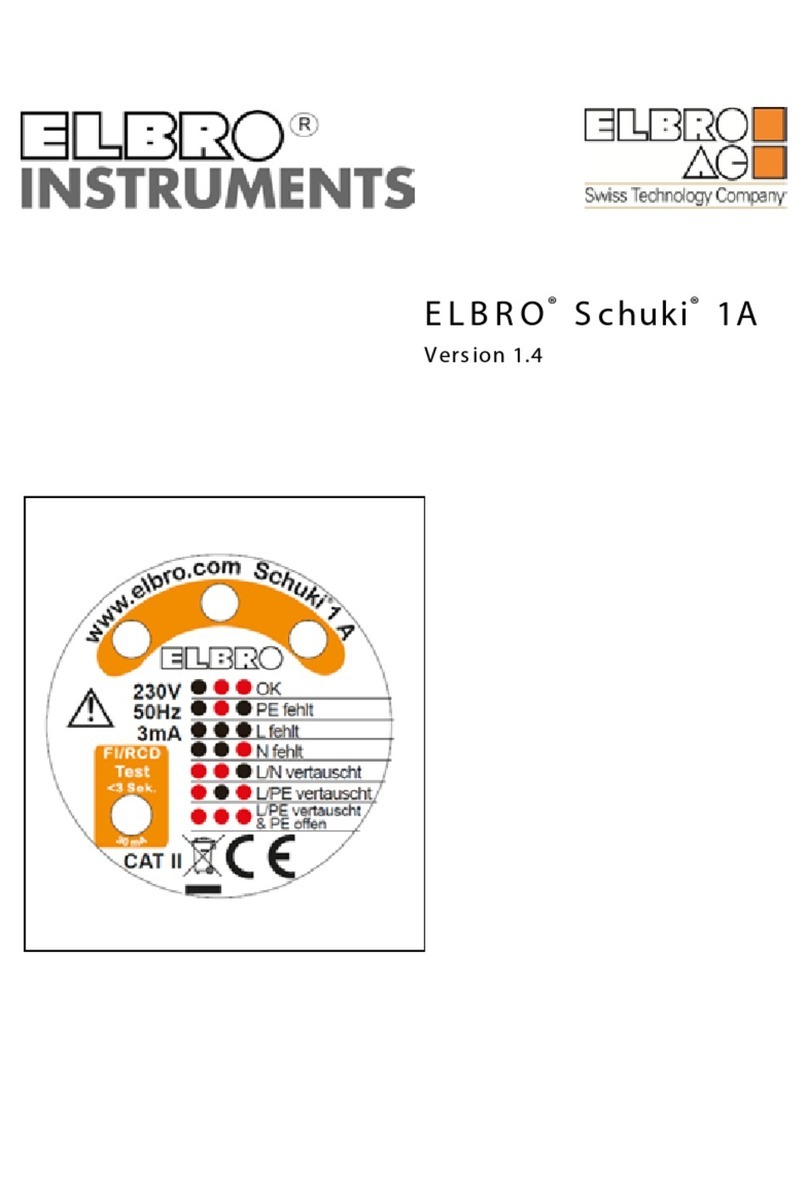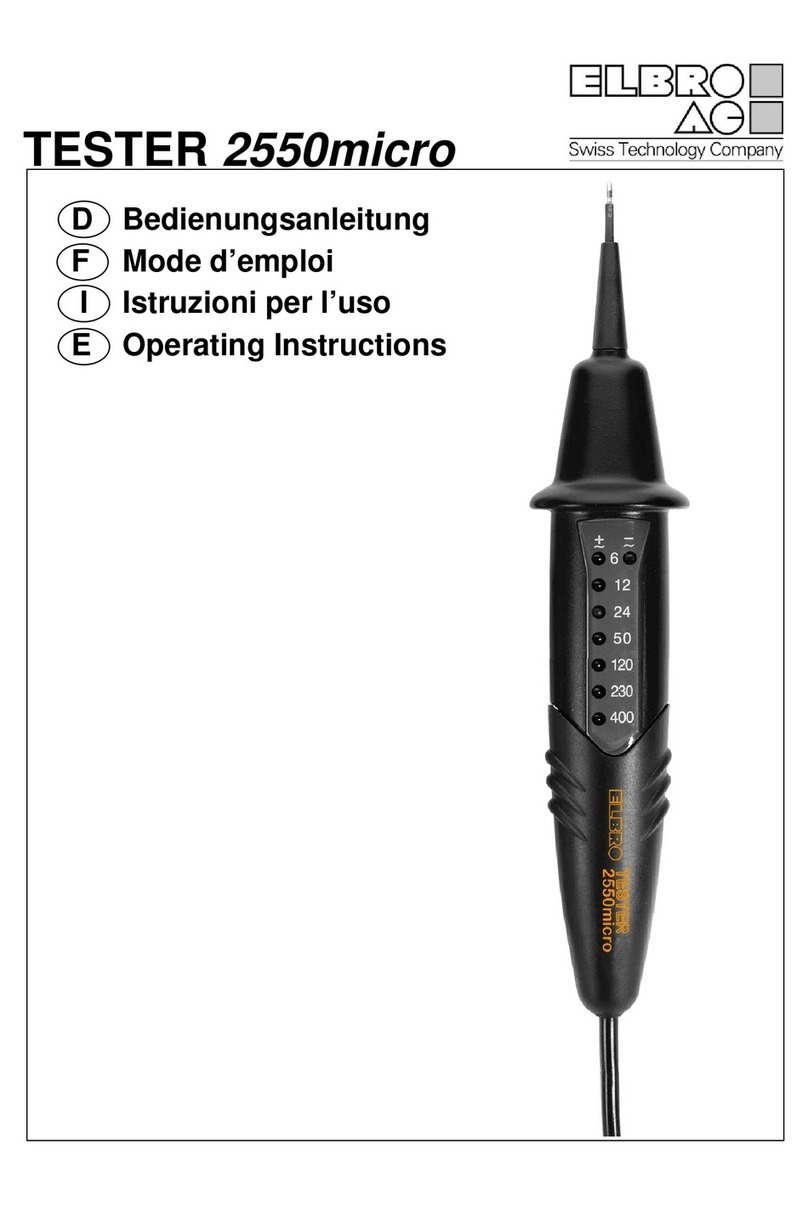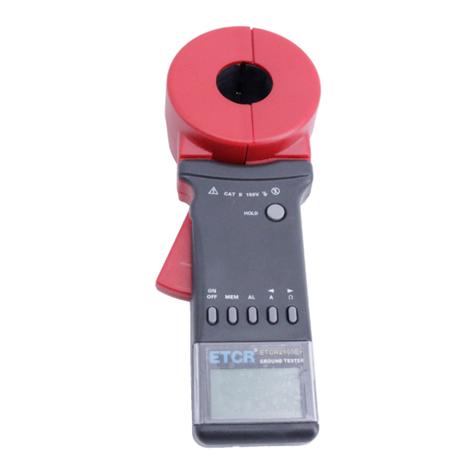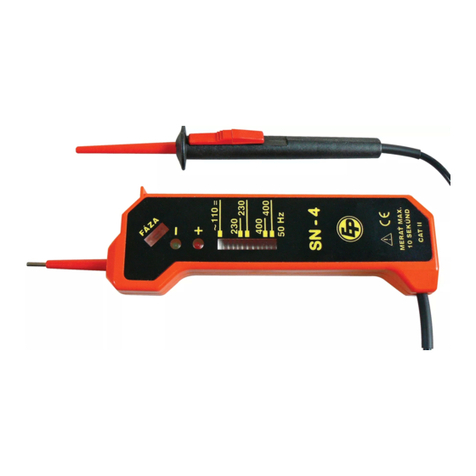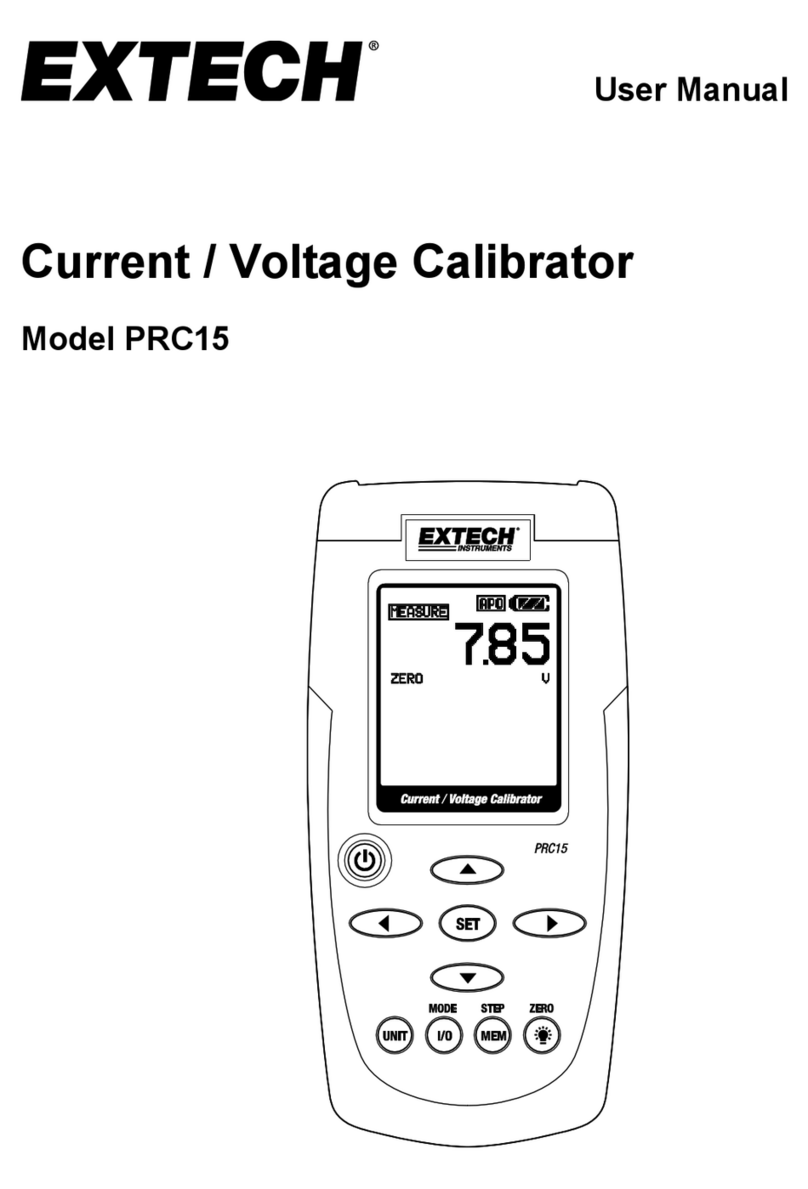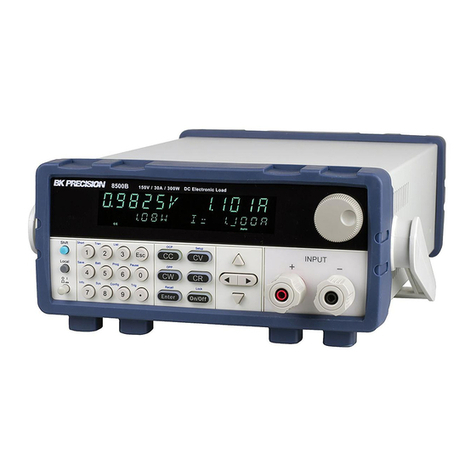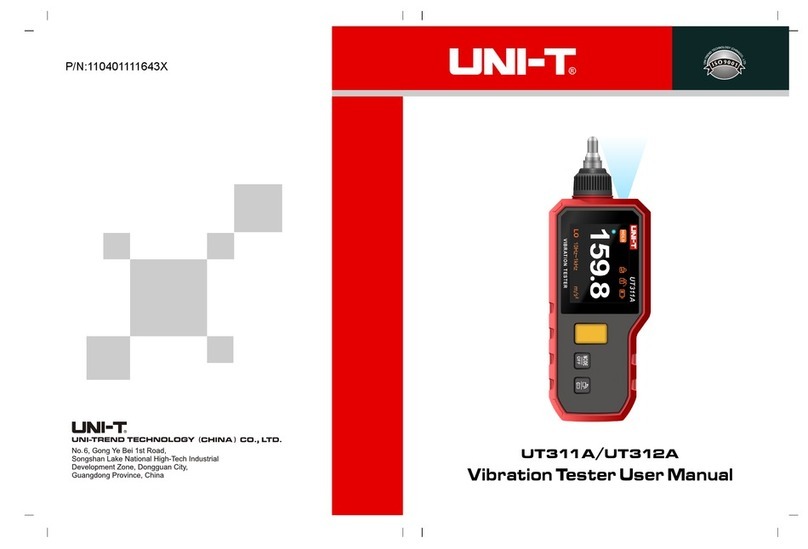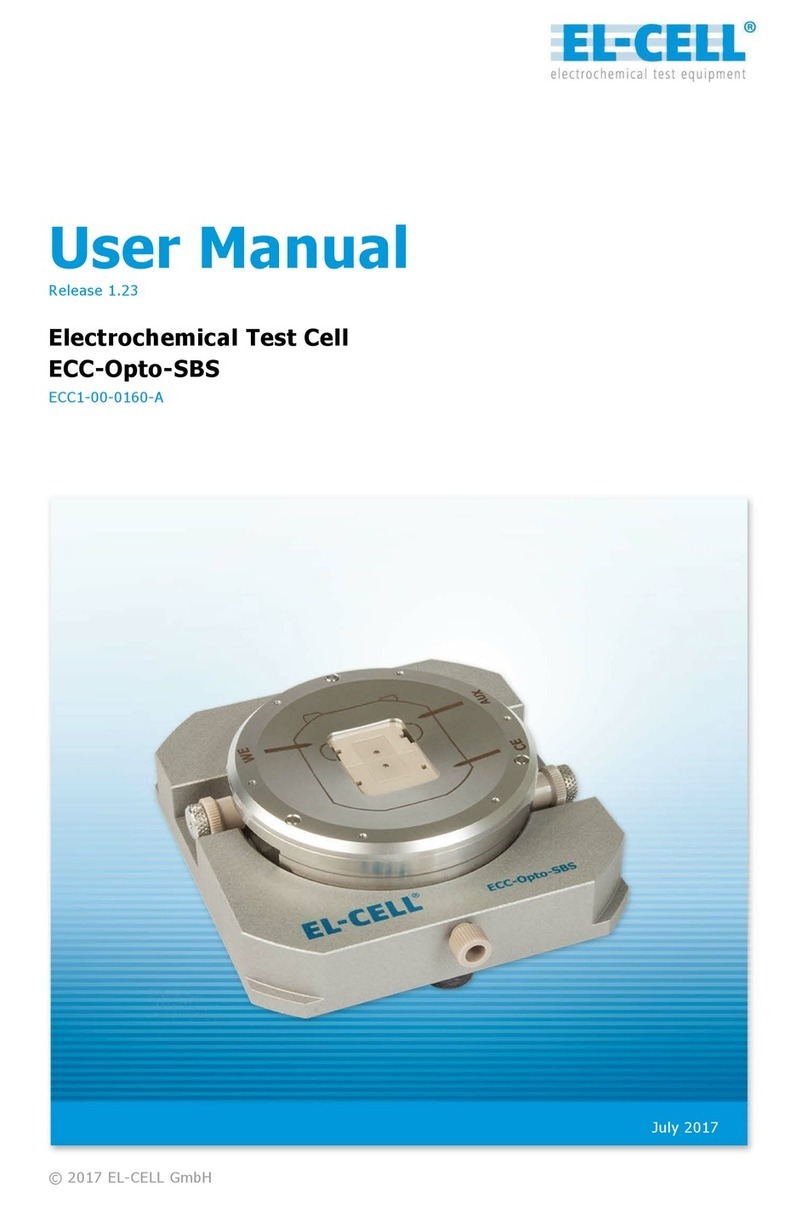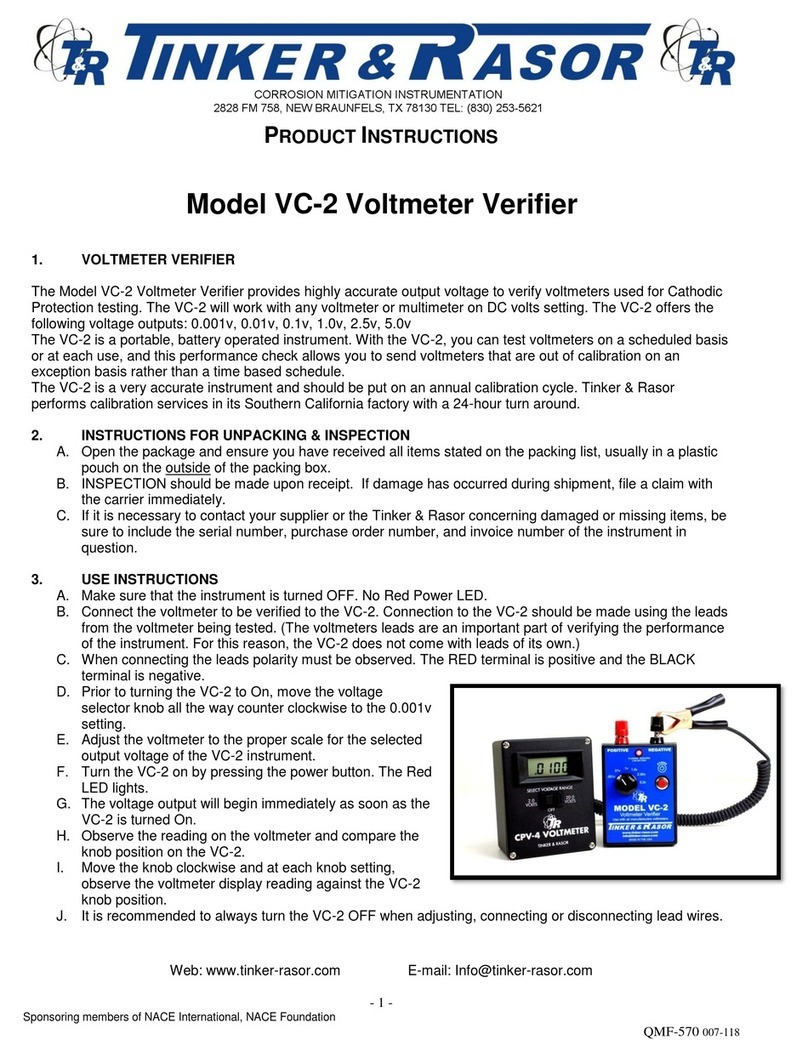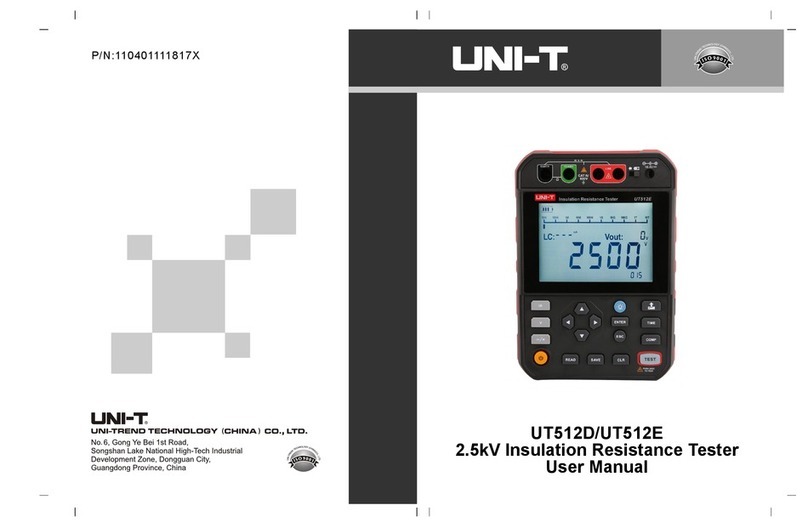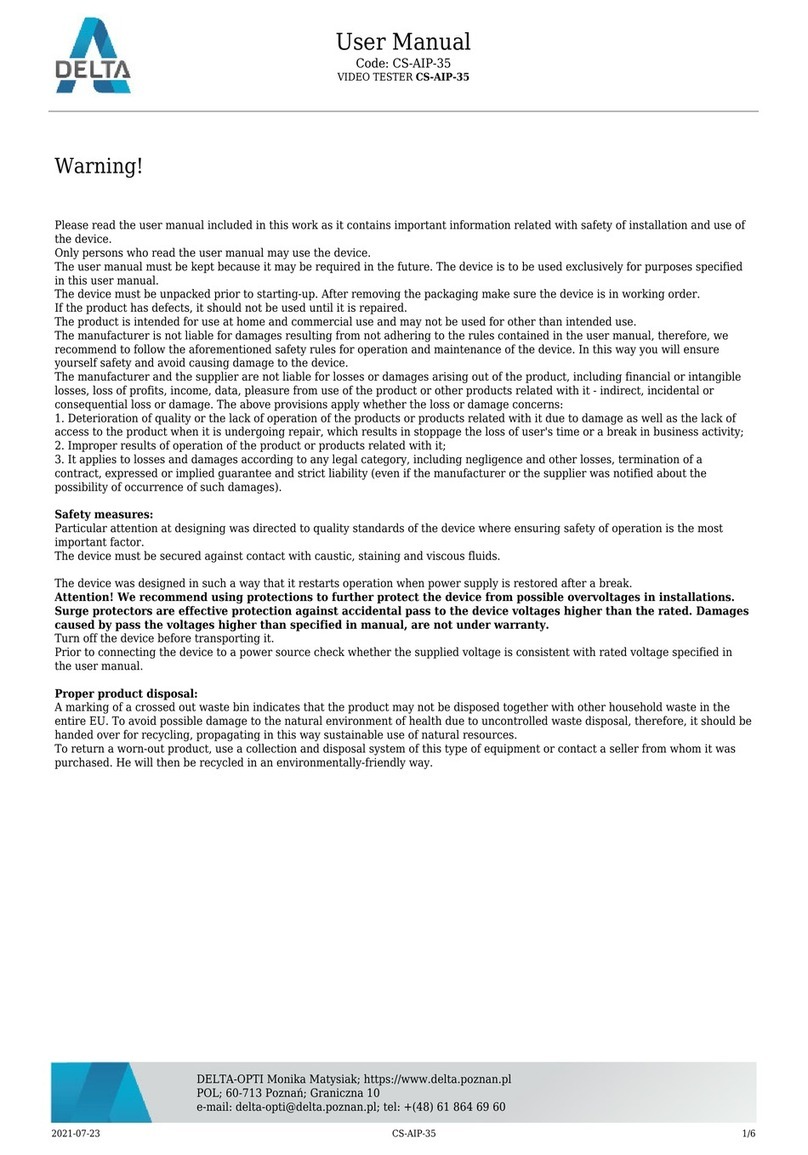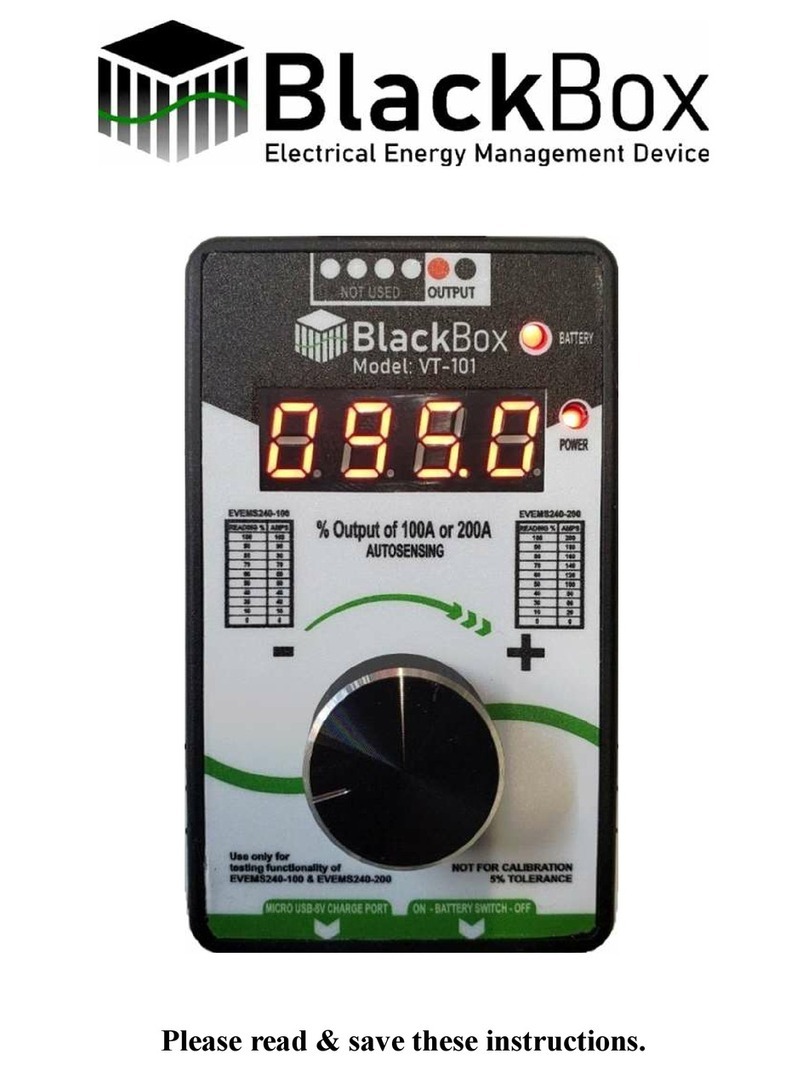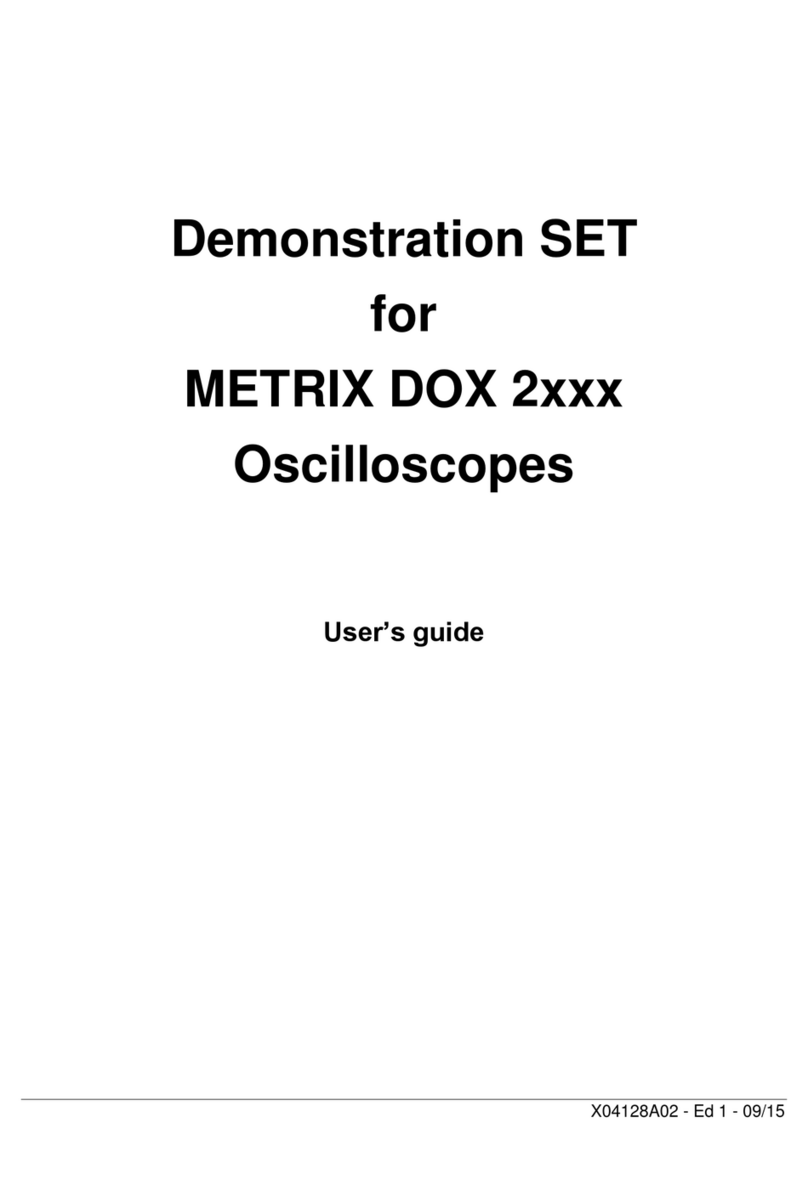ELBRO TESTER 2550LED User manual

D
Bedienungsanleitung
F Mode d’emploi
I Istruzioni per l’uso
E Operating Instructions
TESTER 2550LED

TESTER 2550LED
2
D:Prüfspitzen mit 4mm Adapter
F:Pointes de touche avec adaptateurs 4mm
I: Punte di misura con adattatori 4mm
E:Probe tips with 4mm adapters
D:Fingerkontakt (Rückseite)
F:Contact digital (en arrière)
I :Contatto a dito (posteriore)
E:Finger contact (backside)
D: Schraube Batteriefach
F: Vis compartiment de batterie
I : Vite alloggiamento delle batterie
E: Screw battery compartment
LED’s (ACV, DCV)
D: Durchgangstest
F: Test de continuité
I : Prova di continuità
E: Continuity test
D: Phase/Drehfeld
F: Phase/champ tournant
I : Fase/campo di rotazione
E: Phase/rotary field
D:Tasten für FI/RCD-Auslösetest
F:Touches pour le test FI/RCD
I :Tasti per la prova dell’interruttore diff.
E:Keys for the FI/RCD trip test
D: Phase/Drehfeld
F: Phase/champ tournant
I : Fase/campo di rotazione
E: Phase/rotary field
D: LED Taschenlampe
F: Lampe de poche LED
I : Lampada tascabile LED
E: LED torch

TESTER 2550LED
3
Bedienungsanleitung
Vielen Dank, dass Sie sich für den TESTER 2550LED , einen zweipoligen Spannungsprüfer mit LED-Anzeige,
entschieden haben. Es können Gleich- und Wechselspannungen von 6 bis 1000 V, Polaritäts-, Drehfeldrichtungs-,
Durchgangsprüfungen bis 500kΩund FI/RCD-Tests durchgeführt werden.
Der TESTER 2550LED ist durch die hohe Schutzart (IP65) auch bei rauem Einsatz verwendbar.
1. Sicherheitshinweise
Sie haben sich für ein Gerät entschieden, das Ihnen ein hohes Maß an Sicherheit bietet. Es entspricht den Normen
IEC/EN 61243-3, DIN VDE 0682-401. Um eine gefahrlose und richtige Anwendung sicherzustellen, ist es unerläss-
lich, dass Sie diese Bedienungsanleitung vor dem ersten Gebrauch vollständig durchlesen.
Es gelten folgende Sicherheitsvorkehrungen:
•Der Spannungsprüfer muss kurz vor dem Einsatz auf Funktion übergeprüft werden. Überprüfen Sie das
Gerät an einer bekannten Spannungsquelle, z.B. 230V-Steckdose. Fällt hierbei die Anzeige einer oder
mehrerer Funktionen aus, darf das Gerät nicht mehr verwendet werden und muss von Fachpersonal über-
prüft werden.
•Gerät nur an den Handgriffen anfassen, vermeiden Sie die Berührung der Prüfspitzen!
•Prüfungen auf Spannungsfreiheit nur zweipolig durchführen!
•Eine einwandfreie Anzeige ist nur im Temperaturbereich von –10°C - +50°C sichergestellt.
•Das Gerät immer trocken und sauber halten. Das Gehäuse darf mit einem feuchten Tuch gereinigt werden.
•Das zusätzlich anzeigende Warnsymbol und akustische Anzeige bei Spannungen >35V dienen nur zur
Warnung von lebensgefährlichen Spannungen, nicht zur Messung Das zusätzlich anzeigende Warnsymbol
und akustische Anzeige bei Spannungen >35V dienen nur zur Warnung von lebensgefährlichen
Spannungen, nicht zur Messung.
2. Allgemeines
Spannungen haben Priorität. Liegt keine Spannung an den Messspitzen an (< 3,6V), befindet sich das Gerät im
Modus Durchgangsprüfung. Durch drücken der Taste „Light“ wird die LED Taschenlampe zugeschaltet
3. Selbsttest
Halten Sie zum Test die Prüfelektroden aneinander. Die „Rx/Ω“ - LED muss deutlich leuchten. Sollte die LED nicht
oder nur schwach aufleuchten, müssen die Batterien erneuert werden. Die Spannungsquelle ist für zweipolige
Spannungsprüfungen nicht erforderlich.
Hinweis:
Bei einer Wechselspannung von 35V schaltet das Gerät in den Selbsttestmodus. Hier wird die Elektronik auf
Funktion getestet, dabei leuchten alle LEDs auf! Dies ist ein notwendiger Schritt, damit das Anliegen einer lebens-
gefährlichen Spannung eindeutig angezeigt werden kann.
4. Gleichspannung prüfen
Bei Anlegen der Prüfspitzen an eine Gleichspannung innerhalb des Nennspannungsbereiches leuchtet eine der
unteren (12V +~-) sowie die darüber angeordneten LEDs, entsprechend der anliegenden Spannung, auf. Die unte-
ren LEDs zeigen die Polarität gemäß der Kennzeichnung an den Prüfspitzen an! (+, -)
5. Wechselspannung prüfen
Bei Anlegen der Prüfspitzen an eine Wechselspannung innerhalb des Nennspannungsbereiches leuchten beide
der unteren (12V +~-) sowie die darüber angeordneten LEDs, entsprechend der anliegenden Spannung, auf. Das
gleichzeitige Aufleuchten der unteren LEDs weist auf Wechselspannung hin (~). Bei Überschreitung des eingestell-
ten Schwellenwertes von 35V ertönt ein Signalton.
Dieses signalisiert ein Anliegen lebensbedrohlicher Spannung!

TESTER 2550LED
4
6. Phasenprüfung
Berühren Sie mit einer der Testspitzen einen Leiter und berühren Sie dabei den Fingerkontakt. Bei Anliegen einer
Phase, mind. 100V~, leuchtet die „<L“ - LED auf!
7. Drehfeldprüfung
Stellen Sie nach Punkt 6 die phasenführenden Leiter fest. Legen Sie nun zwei Phasenleiter an die zwei Testspit-
zen an und berühren den Fingerkontakt. Folgt die an der Testspitze L2 anliegende Phase der an der Testspitze L1
anliegende Phase, so ist die Phasenlage rechtsdrehend und „R>“ - LED leuchtet. Ist dies nicht der Fall, liegt ein
linksdrehendes Feld an und die „<L“ - LED leuchtet. Die Spannungsangabe sollte 400V anzeigen. Werden nur
230V angezeigt, liegt nur ein Phasenleiter an!
8. Durchgangsprüfung und Diodentest
Legen Sie die Prüfspitzen an die zu prüfende Leitung, Sicherung o.ä. an. Bei einem Widerstand von 0…500 kΩ
oder bei einer Halbleiterdiode in Durchlassrichtung (Anode liegt an der Prüfspitze + an!) leuchtet die „Rx/Ω“ - LED
auf und ein akustisches Signal ertönt.
9. FI/RCD-Auslösetest, PE (Nullleitertest)
Der 2550LED besitzt eine Last, die es ermöglicht, einen FI/RCD-Schutzschalter mittels zweier Taster (FI\RCD)
auszulösen. Geprüft wird der FI/RCD ( max. 30mA) zwischen Phase und Schutzleiter.(max. 240V)
10. Batteriewechsel
Zum Wechsel der Batterien ist die Schraube unten am Hauptgehäuse zu lösen um den Batteriefachdeckel nach
unten abziehen zu können. Achten Sie beim Einsatz der neuen Batterien auf die richtige Polarität.
Hinweis: Batterien gehören nicht in den Hausmüll. Auch in Ihrer Nähe befindet sich eine Sammelstelle!
11. Technische Daten
Anzeige: 13 LEDs für Spannung (12, 24, 48, 120, 230, 400, 690 und 1000 V), Polarität
(+~-), Durchgang (Rx/Ω) und Phase/Drehfeld (R/L) + PELV
Nennspannungsbereich: 6…1000V AC/DC
Frequenzbereich: 0…400Hz
Prüfstrom: ~30mA
Einschaltdauer: 30s
Durchgangsprüfung: 0…500kΩ
Schutzart: IP65
Überspannungskategorie: CAT IV 1000V
Sicherheit nach: IEC/EN 61243-3, DIN VDE 0682-401
Stromversorgung: 2x 1,5V Typ AAA Micro
12. Konformitätserklärung
Das Produkt erfüllt die Niederspannungsrichtlinien 2006/95/EG und die EMV-Richtlinien 2004/108/EG.
.

TESTER 2550LED
5
13. Anwendungsbereich
Das Gerät ist nur für die in der Bedienungsanleitung beschriebenen Anwendungen bestimmt. Eine andere Ver-
wendung ist unzulässig und kann zu Unfällen oder Zerstörung des Gerätes führen. Diese Anwendungen führen zu
einem sofortigen Erlöschen jeglicher Garantie- und Gewährleistungsansprüche des Bedieners gegenüber dem
Hersteller.
14. 24 Monate Garantie
Der TESTER 2550LED unterliegt einer strengen Qualitätskontrolle. Sollten während der täglichen Praxis dennoch
Fehler in der Funktion auftreten, gewähren wir eine Garantie von 24 Monaten (nur gültig mit Rechnung).
•Fabrikations- oder Materialfehler werden von uns kostenlos beseitigt, sofern das Gerät ungeöffnet an uns
zurückgesandt wird.
•Beschädigungen durch Sturz oder falsche Handhabung sind vom Garantieanspruch ausgeschlossen.
Treten nach Ablauf der Garantiezeit Funktionsfehler auf, wird unser Werkservice Ihr Gerät unverzüglich wieder
instand setzen.
Bitte wenden Sie sich an:
ELBRO AG •Gewerbestrasse 4 •CH-8162 Steinmaur •Telefon +41 (0)44 854 73 00
Telefax +41 (0)44 854 73 01 •e-mail: info@elbro.com •www.elbro.com
Diese Bedienungsanleitung wurde mit großer Sorgfalt erstellt. Für die Richtigkeit und Vollständigkeit der Daten,
Abbildungen und Zeichnungen wird keine Gewähr übernommen.
Technische Änderungen vorbehalten

TESTER 2550LED
6
Mode d’emploi
Nous vous remercions d’avoir opté pour le TESTER 2550LED , un détecteur de tension bipolaire avec affichages à
LED. Cet appareil de mesure permet d’effectuer des tests de tensions continues et alternatives comprises entre 6
et 1000 V, des tests de polarité, d’ordre des phases du champ rotatif et de continuité jusqu’à 500 kΩ, ainsi que des
tests FI/RCD.
Le TESTER 2550LED peut être également utilisé dans des milieux fortement sollicités grâce à son indice de pro-
tection élevé (IP65).
1. Indications de sécurité
Vous avez fait l’acquisition d’un appareil de mesure offrant une sécurité élevée et répondant aux normes IEC/EN
61243-3 et DIN VDE 0682-401. Avant la première utilisation, il est indispensable de parcourir entièrement le mode
d’emploi afin de garantir un fonctionnement approprié et sans risque.
Les mesures de sécurité suivantes sont à respecter
•Le bon fonctionnement du détecteur de tension doit être vérifié avant son utilisation. Contrôler l’appareil sur
une source de tension familière, p. ex. une prise électrique 230 V. Si l’affichage d’une ou de plusieurs fonc-
tions échoue, l’appareil ne devra plus être utilisé et devra être contrôlé par du personnel qualifié.
•Prendre l’appareil en main en évitant tout contact direct avec les pointes de test !
•Les tests d’absence de tension doivent s’effectuer exclusivement avec les deux pôles !
•Un affichage irréprochable est assuré dans une plage de température de –10 °C à + 50 °C.
•Toujours maintenir l’appareil dans un état propre et sec. Le boîtier de l’appareil peut être nettoyé avec un
chiffon humide.
•Le symbole d’avertissement qui apparaît et le signal sonore qui retentit lorsque la tension est > 35 V signa-
lent uniquement les tensions dangereuses. Il ne s’agit pas d’un relevé de mesure
2. Généralités
La mesure de tension est prioritaire. L’appareil se trouve en mode «Test de continuité» lorsque les pointes de test
sont hors tension (< 3,0V). Appuyer sur la touche « Light » pour allumer la lampe de poche DEL
3. Autotest
Maintenir les pointes de test l’une contre l’autre. La LED Rx/Ω» doit alors s’illuminer distinctement. Les piles de-
vront être remplacées si la LED ne s‘illumine pas ou faiblement. L’alimentation par piles n’est pas indispensable
pour les tests de tension bipolaires.
Indication :
En présence d’une tension alternative de 35V, l’appareil commute alors en mode autotest. La fonctionnalité de
l’électronique est alors testée et toutes les LED s’illuminent ! C’est une étape nécessaire afin de clairement signaler
la présence d’une valeur de tension à risque d’électrocution !
4. Contrôle de la tension continue
En appliquant les pointes de test sur une source de tension continue comprise dans la gamme de tension nominale,
l’une des LED inférieures (12V +~-) ainsi que des LED supérieures s’illuminent en fonction de la valeur de tension
présente. Les LED inférieures indiquent la polarité selon le marquage respectif des pointes de test (+, -).
5. Contrôle de la tension alternative
En appliquant les pointes de test sur une tension alternative comprise dans la gamme de tension nominale, les
deux LED inférieures (12 V +~-) ainsi que des LED supérieures s’illuminent en fonction de la valeur de tension
présente. L’illumination simultanée des LED inférieures signale une tension alternative (~). En cas de dépassement
de la valeur de seuil ajustée à 35 V, vous entendez un signal sonore.
Signalant ainsi la présence d’une valeur de tension à risque d’électrocution !

TESTER 2550LED
7
6. Contrôle de phase
Appliquer l’une des pointes de test sur un conducteur tout en effleurant simultanément le contact digital. La LED
«<L » s’illumine en présence d’une tension de phase d’au moins 100 V~.
7. Contrôle du champ rotatif
Localiser les conducteurs de phase selon le point 6. Appliquer ensuite les deux pointes de test sur deux lignes de
phase tout en effleurant le contact digital. Si la phase raccordée à la pointe de test L2 suit la phase raccordée à la
pointe de test L1, le champ tourne alors à droite et la LED « R> » s’illumine. Dans le cas contraire, le champ tourne
à gauche et la LED « <L » s’illumine. La tension indiquée devrait être d’environ 400 V. Si la tension indiquée
n’atteint que 230 V, le circuit est alors monophasé !
8. Test de continuité et test de diode
Appliquer les pointes de test sur la ligne, fusible ou diode à tester. La LED « Rx/Ω» s’illumine et un signal acousti-
que retentit en cas de résistance comprise entre 0… 500 kΩou d’un seuil de diode semi-conductrice dans le sens
conducteur (anode reliée à la pointe de test +).
9. Test de déclenchement FI/RCD, PE (test du conducteur neutre)
Le testeur 2550LED dispose d’une charge qui permet de déclencher un disjoncteur FI/RCD à l’aide de deux bou-
tons (FI/RCD). Le FI/RCD est contrôlé entre la phase et le disjoncteur (tension de contrôle max. 240 V)
10. Remplacement des piles
Pour remplacer les piles, desserrer la vis située en bas du boîtier principal afin de pouvoir retirer le couvercle du
compartiment à piles vers le bas. S’assurer de la polarité correcte des nouvelles piles !
Indication : les piles usagées ne doivent pas être éliminées avec les ordures ménagères. Un site de ré-
cupération est certainement disponible à proximité.
11. Données techniques
Affichage: 13 LED pour indication de tension (12, 24, 48, 120, 230, 400, 690 et 1000 V), pola-
rité (+~-), continuité (Rx/Ω) et phase/champ rotatif (R/L) + PELV
Gamme de tension : 6...1000V AC/DC
Gamme de fréquence : 0...400Hz
Courant de test : ~30mA
Durée opérationnelle : 30s
Test de continuité : 0…500 kΩ
Indice de protection : IP65
Catégorie de surtension : CAT IV 1000V
Homologation selon : IEC/EN 61243-3, DIN VDE 0682-401
Alimentation : 2 piles 1,5V de type AAA Micro
12. Déclaration de conformité
Ce produit répond aux prescriptions de la Directive Basse tension 2006/95/EGet de la directive Compactibilité
Electromagnétique 2004/108/EG.

TESTER 2550LED
8
13. Domaine d’utilisation
L’appareil est uniquement destiné aux applications décrites dans le mode d’emploi.
Toute autre utilisation non appropriée n’est pas admissible et peut provoquer des accidents ou la destruction de
l’appareil. Ces utilisations non appropriées impliquent l’extinction immédiate de toute garantie et de prétention sous
garantie de la part de l’utilisateur envers le fabricant.
14. Garantie de 24 mois
Les appareils Elbro sont soumis à un contrôle de qualité très strict. Si des défauts fonctionnels devaient toutefois
survenir en utilisation quotidienne pendant la durée de garantie de 24 mois (uniquement valable avec facture à
l'appui) :
•Les défauts de fabrication ou de matériel seront éliminés gratuitement par nos soins, pour autant que l'ap-
pareil nous ait été retourné sans avoir été ouvert au préalable.
•Des dégâts consécutifs à des sollicitations mécaniques ou une manipulation erronée sont exclus des pré-
tentions sous garantie.
Notre service après-vente remettra votre appareil en état si des défauts fonctionnels devaient survenir après la
période de garantie.
Veuillez s.v.p. contacter :
ELBRO AG •Gewerbestrasse 4 •CH-8162 Steinmaur •Telefon +41 (0)44 854 73 00
Telefax +41 (0)44 854 73 01 •e-mail: info@elbro.com •www.elbro.com
Bien que ce mode d'emploi ait été rédigé avec le plus grand soin, nous ne pouvons toutefois endosser aucune
responsabilité quant à l'exactitude et la validité des données, illustrations et autres schémas publiés.
Sous réserve de modifications techniques, sans préavis

TESTER 2550LED
9
Istruzioni per l’uso
Grazie per aver acquistato il TESTER 2550LED , un tester a due poli con display LED. È possibile eseguire dei
controlli su tensioni continue ed alterne comprese fra 6 e 1000 V, controlli sulla polarità, la direzione del campo di
rotazione e prove di continuità fino a 500 kΩe test FI/RCD.
Il TESTER 2550LED può essere impiegato grazie all’elevato tipo di protezione (IP65) anche in caso d’impiego
ruvido.
1. Avvertenze di sicurezza
Ha deciso di acquistare un apparecchio che offre il massimo in termini di sicurezza. È conforme alle norme DIN
VDE 0682-401, IEC/EN 61243-3. Per assicurare un funzionamento corretto e privo di pericoli è indispensabile leg-
gere attentamente il presente manuale d’uso prima del primo impiego dell’apparecchio.
Sono valide le seguenti procedure di sicurezza:
•Poco prima dell’impiego il tester deve essere controllato di essere perfettamente funzionante. Controllare
la funzionalità dell’apparecchio ad una fonte di tensione nota come ad esempio una presa da 230V. Se in
questo caso una o più indicazioni non si attivano è necessario che l'apparecchio non venga più utilizzato e
deve essere sottoposto ad un controllo ad opera di personale specializzato.
•Impugnare l’apparecchio solo alle maniglie, evitare il contatto con le punte di controllo!
•Eseguire i controlli sull’assenza di tensione solo su due poli!
•Una indicazione perfetta è assicurata in un intervallo termico di –10°C e +50°C.
•Mantenere l’apparecchio sempre asciutto e pulito. L’alloggiamento può essere pulito con uno straccio umi-
do.
•Il simbolo di avvertimento visualizzato in aggiunta e la segnalazione acustica inviata per tensioni >35V fun-
gono esclusivamente da avvertimento di tensioni pericolose per la vita, non servono per la misura
2. Generalità
Le tensioni hanno priorità. Se sulle punte di misurazione non è presente alcuna tensione (< 3,0V), l’apparecchio è
in modalità di prova di continuità. Premendo il tasto “Light” si attiva la lampada tascabile
3. Autotest
Unite per un test le due punte di controllo. Deve attivarsi il cicalino e l’indicatore visualizzare „Rx/Ω“. Se il display
LED non dovesse illuminarsi o farlo solo debolmente, è necessario sostituire le batterie.
Avvertenza
Con una tensione alternata di 35 V, l'apparecchio si porta in modalità autotest e procede a un controllo di funzio-
namento dell'elettronica; tutti i led si illuminano! Questa è una procedura necessaria, affinché l'apparecchio possa
visualizzare chiaramente una tensione pericolosa.
4. Controllare la tensione continua
Applicando le punte di controllo a una tensione continua che rientra nel campo di tensione nominale, si illuminano
uno dei LED inferiori (12V +~-) e i LED superiori in funzione della tensione misurata. I LED inferiori indicano la po-
larità in base ai contrassegni sulle punte di controllo! (+, -)
5. Controllare la tensione alternata
Applicando le punte di controllo a una tensione alternata che rientra nel campo di tensione nominale, si illuminano
entrambi i LED inferiori (12V +~-) e i LED superiori in funzione della tensione misurata. I due LED inferiori si illumi-
nano contemporaneamente in presenza di una tensione alternata (~). In caso di superamento del valore soglia di
35 V si attiva un segnale acustico.
Questo segnala la presenza di una tensione che mette in pericolo la vita!

TESTER 2550LED
10
6. Controllo fasi
Toccare con una delle punte di controllo un conduttore e quindi il contatto a dito. In presenza di una fase, almeno
100V~, il LED “<L” si illumina!
7. Controllo del campo di rotazione
Determinare come da punto 6 un conduttore di fase. Posizionare quindi due conduttori di fase sulle punte di con-
trollo e toccare il contatto a dito. Se a fase sulla punta di controllo L2 segue quella della punta di controllo L1, la
posizione di fase è destrorsa ed il LED “R>” s’illumina Se questo non è il caso, è presente una rotazione sinistrorsa
ed il LED “<L” s’illumuna. L’indicazione della tensione dovrebbe essere di ca. 400V. Se il visualizzati solo 230V, è
attivo solo un conduttore di fase!
8. Prova di continuità
Applicare le punte di controllo al conduttore, al fusibile, ecc. da testare. Con una resistenza di 0...500 kΩo un dio-
do semiconduttore nel senso di conduzione (punta di controllo + applicata all'anodo!), il LED “Rx/Ω” si illumina e
viene emesso un segnale acustico.
9. Test di rilascio FI/RCD, PE (test conduttore neutro)
Il tester 2550LED è dotato di un carico che permette di far scattare un interruttore di protezione FI/RCD mediante
due tasti (FI/RCD) . L’FI/RCD è controllato tra fase e conduttore di protezione (tensione di prova max. 240 V)
10. Sostituzione delle batterie
Per sostituire le batterie è necessario svitare la vite sotto l’alloggiamento principale per poter estrarre il coperchio
dell’alloggiamento delle batterie verso il basso. Accertarsi di inserire le batterie con la giusta polarità.
Avvertenza: Le batterie non vanno gettate insieme ai rifiuti domestici. Consegnarle ad un centro di raccolta!
11. Dati tecnici
Visualizzazione 13 LED per tensione (12, 24, 48, 120, 230, 400, 690 e 1000 V), polarità (+~-), con-
tinuità (Rx/Ω) e fase/campo rotante (R/L) + PELV
Tensione: 6...1000V AC/DC
Frequenza: 0...400Hz
Corrente di prova: ~30mA
Intervallo d’inserimento: 30s
Prova di continuità: 0...500kΩ
Carico automatico : (interruttore differenziale) si
Classe di protezione: IP65
Categoria di sovratensione: CAT IV 1000V
Sicurezza conforme a: IEC/EN 61243-3, DIN VDE 0682-401
Alimentazione: 2x 1,5V Type AAA Micro
12. Dichiarazione di conformità
Il prodotto corrisponde alla norma di basse tensione 2006/95/EGe alla EMV 2004/108/EG.

TESTER 2550LED
11
13. Campo d’impiego
L’apparecchio è progettato esclusivamente per gli impieghi descritti nelle istruzioni per l’uso.
Un impiego diverso è da considerarsi inammissibile e potrebbe causare lesioni alle persone e danni all’apparecchio.
In questo caso viene immediatamente a decadere qualsiasi richiesta di garanzie da parte dell’utente nei confronti
del produttore.
14. 24 mesi di garanzia
Gli apparecchi Elbro sono sottoposti a severi controlli di qualità. Se nella pratica quotidiana dovessero tuttavia
verificarsi degli errori di funzionamento, rilasciamo una garanzia di 12 mesi (valida solo con presentazione della
fattura).
●Eliminiamo gratuitamente i difetti di fabbricazione e di materiale a condizione che
l'apparecchio ritornatoci non sia stato aperto e non abbia subìto interventi di terzi.
●I danni risultanti da sollecitazioni meccaniche o uso improprio non sono coperti dalla garanzia.
Se si verificano degli errori di funzionamento dopo il periodo di garanzia, il nostro servizio di assistenza è in grado
di provvedere alla riparazione dell'apparecchio.
Indirizzo di contatto:
ELBRO AG •Gewerbestrasse 4 •CH-8162 Steinmaur •Telefon +41 (0)44 854 73 00
Telefax +41 (0)44 854 73 01 •e-mail: info@elbro.com •www.elbro.com
Queste istruzioni per l'uso sono state realizzate con la massima cura. Non si assume tuttavia alcuna responsabilità
in merito a correttezza e completezza di dati, illustrazioni e disegni.
Con riserva di modifiche tecniche

TESTER 2550LED
12
Operating Instructions
Thank you for purchasing our TESTER 2550LED . The device can be used to detect DC and AC voltages of be-
tween 6 and 1000 V, for polarity, phase sequence and throughput testing at up to 500 kΩ, and for FI/RCD tests.
The TESTER 2550LED carries a high protection rating (IP65), making it suitable for use in harsh conditions.
1. Notes on safety:
You have selected a device that is designed to offer you a high degree of safety. It conforms to standards DIN VDE
0682-401 and IEC/EN 61243-3. In order to ensure that the unit is operated correctly and safely, read these operat-
ing instructions thoroughly BEFORE operating the device.
The following safety precautions should be observed:
•Check the voltage tester for correct functioning immediately before each use, by connecting it to a known
voltage source (e.g. a 230V power socket). If the indicator shows that one or more functions are not work-
ing correctly, do not use the device any further, but have it examined by a qualified service technician.
•Always hold the device by its handles. Avoid touching the probe tips.
•Note that all testing for no voltage should be carried out at two poles.
•Trouble-free operation is guaranteed at temperatures of between -10°C and +50°C.
•Keep the device clean and dry at all times. The casing may be cleaned by wiping with a damp cloth.
The additional warning triangle and acoustical signal >35V is only for warning of life risk not for
measuring. The audible indication should be considered against noise environment for audibility
2. General points
Voltages have priority. If no voltage is detected at the probe tips (< 3.6V), the device is in throughput testing mode.
By pressing the “Light”switch the LED torch will be switched on
3. Self testing
Hold the probe tips together when carrying out this test. The Rx/ΩLED must light up brightly. Otherwise, the batter-
ies must be replaced.
Note:
If measuring 35 V AC or more, the tester performs a self test whereas all LED’s will light up. This step is necessary
to display a life-threatening voltage!
4. DC voltage testing
When the probe tips are connected to a DC voltage within the nominal voltage range, the LED corresponding to the
voltage will light up. One of the LEDs beside “12” will light up to show the polarity corresponding to “+” and “-“ on
the probe tips.
5. AC voltage testing
When the probe tips are connected to an AC voltage within the nominal voltage range, the LED corresponding to
the voltage will light up. Both of the LEDs beside “12” will light up. From a voltage more than 35 V (life risk) a
buzzer sounds up.
6. Phase testing
Bring one of the probe tips into contact with a conductor, while touching the finger contact located at the back.
When a phase of min. 100V~ is connected, the “<L” LED will light up.

TESTER 2550LED
13
7. Rotating field testing
Identify a phase conducting wire as described in point 6. Now connect two phase conductors to the probe tips and
touch the finger contact. If the phase connected to probe tip L2 follows the phase connected to probe tip L1, the
phase sequence is right-handed. The “R>” LED lights up. If this is not the case, there is a left-turning field and the
“<L” LED lights up. The voltage indicator should give a reading of approx. 400V. If the only reading is 230 V, only
one phase conductor is connected.
8. Continuity / diode testing
Bring the probe tips into contact with the conductor, fuse or resistance that is being tested. From 0 … 500 kΩ or
with the “+” probe tip at a the anode of a diode, the “Rx/Ω” LED lights up and you will hear an acoustic signal
sounds.
9. Voltage test with RCD trip test
The Tester 2550LED is equipped with a switchable load, which permits the testing of FI/RCD-safety switches. The
FI/RCD safety switch (max. 30 mA) is triggered.( max. 240V)
10. Battery replacement:
To replace the batteries, release the screw under the main casing and pull the battery compartment cover down-
ward to remove. Observe the correct polarity when inserting the new batteries.
Note: Batteries should not be disposed of as normal household waste. Take them to an approved collection point.
11. Technical Data
Display: 13 LEDs for voltage (12, 24, 48, 120, 230, 400, 690 and 1000V), polarity (+~-),
continuity (Rx/Ω) and phase/rotating field (R/L) + PELV
Voltage range: 6...1000V AC/DC
Frequency range: 0...400Hz
Test current: ~30mA
Operation time: 30s
Continuity test: 0 … 500 kΩ
Type of protection: IP65
Overvoltage class: CAT IV 1000V
Safety complying: IEC/EN 61243-3, DIN VDE 0682-401
Power supply: 2x 1,5V Typ AAA Micro
12. Declaration of conformity
This product is in conformity with standards of low voltage and in accordance with the regulations 2006/95/EC,
2004/108/EC.
.
13. Fields of application
The tool is intended for use in applications as described in the operating instructions only.
Any other form of usage is not permitted and can lead to accidents or destruction of the device. Any misuse will
result in the expiry of all guarantee and warranty claims on the part of the operator against the manufacturer.

TESTER 2550LED
14
14. 24 Month Guarantee
Elbro devices are manufactured under strict quality control. If nevertheless functional faults occur during daily us-
age, they are covered by a guarantee of 24 months (valid only with receipt).
●We will eliminate any manufacturing or material faults without charge providing the unit was not opened or
subjected to external influences and was returned to us.
●Damage resulting from mechanical effects or improper handling are not covered by the guarantee.
Our service department will correct faults occurring after expiry of the guarantee.
Please contact us at:
ELBRO AG •Gewerbestrasse 4 •CH-8162 Steinmaur •Telefon +41 (0)44 854 73 00
Telefax +41 (0)44 854 73 01 •e-mail: info@elbro.com •www.elbro.com
These Operating Instructions have been prepared with great care. No liability will be accepted with respect to the
correctness or completeness of the data, illustrations and drawings.
Technical Changes Reserved

TESTER 2550LED
15

TESTER 2550LED
16
•Besuchen Sie unsere Homepage. Dort finden Sie weitere Tester und Messgeräte für je-
den Einsatzzweck.
•Visitez notre Homepage. Là vous trouverez d’autres appareils de test et des instruments
de mesure pour chaque but.
•Visitate la nostra Homepage. Là troverete altri strumenti di controllo o di misura per ogni
impiego.
•Visit our Homepage and find other testers and measuring instruments for each purpose.
www.elbro.com
Table of contents
Languages:
Other ELBRO Test Equipment manuals
